The first eight weeks of a kitten’s life are crucial for their development. During this period, kittens undergo various physical and behavioral changes. Understanding the milestones of a kitten’s growth is essential in determining when to stop stimulating them and allowing them to develop naturally.
Welcome to my blog post about when to stop stimulating kittens for healthy growth. As a cat lover and experienced feline enthusiast, I understand the importance of providing the right environment and care for these adorable little creatures. In this article, I will guide you through the developmental milestones of kittens and help you understand when it’s time to step back and let nature take its course. Let’s dive in!
Key Takeaways:
- Understanding the milestones of a kitten’s growth is essential for their healthy development.
- The first eight weeks of a kitten’s life are crucial for their physical and behavioral changes.
- Knowing when to stop stimulating kittens allows them to develop naturally.
- Providing a warm and stable environment is vital for their well-being.
- Monitoring their growth and introducing proper nutrition at the right time is essential.
Developmental Milestones of Newborn Kittens
Newborn kittens experience significant physical and behavioral changes as they navigate their first few weeks of life. These tiny creatures are born blind and vulnerable, relying entirely on their mother for survival. It is crucial to provide a warm and stable environment for newborn kittens as they are unable to regulate their own body temperature. Additionally, they rely on their sense of smell and seeking warmth to navigate their surroundings, as they are unable to hear or see.
During this stage, newborn kittens spend the majority of their time sleeping and depend on their mother for feeding, cleaning, and bathroom support. It is important to note that their eyes and ears are closed, and they communicate primarily through scent and touch. As they grow, their eyes and ears gradually open, allowing them to experience the world around them. However, it is important to remember that their vision and hearing are still developing, and they continue to rely on their mother for guidance and care.
“Newborn kittens are born blind and defenseless, relying heavily on their mother for survival.”
The development of newborn kittens is a fascinating process to witness. As they reach different milestones, such as the gradual opening of their eyes and ears, their physical abilities and coordination start to improve. However, it is important to provide a nurturing and supportive environment for these delicate creatures, ensuring they receive the warmth, nutrition, and care they need for healthy growth.
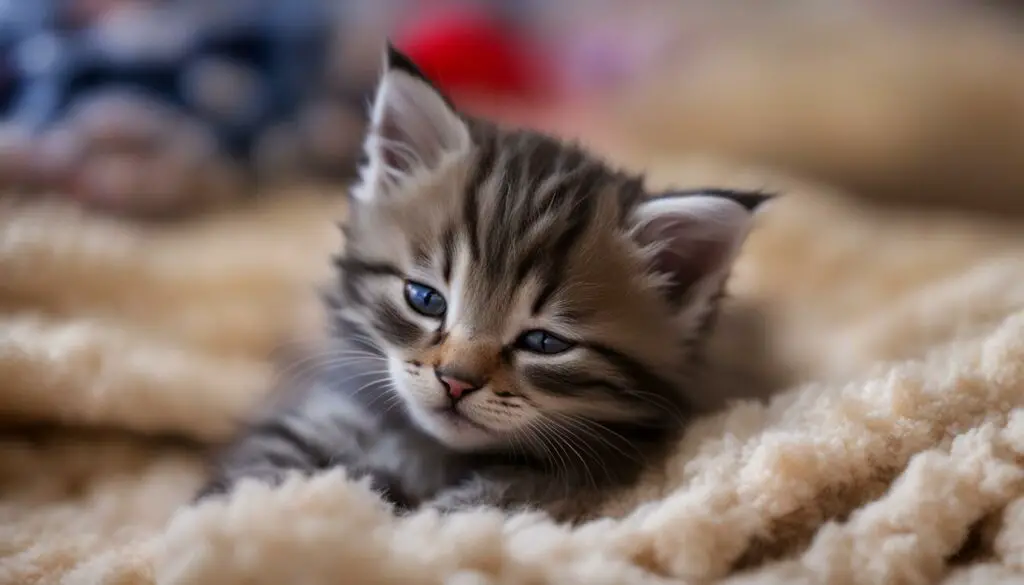
Summary:
- Newborn kittens are born blind and vulnerable, relying on their mother for survival.
- They navigate their surroundings through scent and seeking warmth.
- During this stage, they sleep for the majority of the day and depend on their mother for feeding, cleaning, and bathroom support.
- Their eyes and ears gradually open, and their physical abilities and coordination start to improve.
- Providing a warm and stable environment is essential for their well-being.
Developmental Milestones of One-Week-Old Kittens
One-week-old kittens are beginning to show signs of development in both their physical and behavioral abilities. While they are still dependent on their mother for essential care, they are slowly starting to gain more control over their bodies.
Physically, one-week-old kittens are experiencing the gradual opening of their ears, allowing them to become more receptive to the sounds around them. Their eyes, although still closed, may begin to show signs of emerging as they prepare to explore the world visually. While their coordination is still limited, these tiny creatures can now hold their heads up and move their limbs with increasing strength and purpose.
Behaviorally, one-week-old kittens primarily focus on sleeping and feeding, as their bodies require ample rest and nourishment for proper growth. They rely on their mother for nutrition and care, relying on her to provide warmth and sustenance. As they continue to develop, their instincts will drive them to seek nourishment and comfort from their mother’s presence.
Creating a warm and comfortable environment is crucial for the well-being of these one-week-old kittens. It is recommended to provide a secure and quiet space where they can easily access their mother for feeding and care. Maintaining a consistent temperature within the environment is also important, as their bodies are still unable to regulate their own body heat effectively.
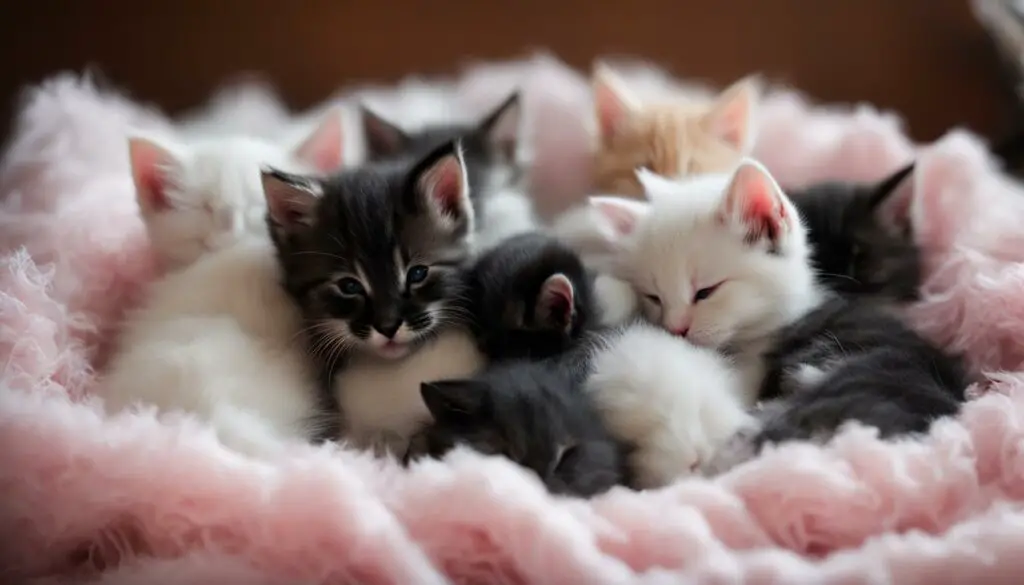
Table: Developmental Milestones of One-Week-Old Kittens
| Physical Development | Behavioral Development |
|---|---|
| The gradual opening of ears | Sleeping for the majority of the day |
| The slow emergence of eyes | Dependence on mother for feeding |
| Ability to hold their heads up | Reliance on mother for care |
| Improved limb movement | Seeking warmth and comfort from mother |
As these one-week-old kittens continue to grow and develop, it is important to monitor their progress closely and provide the necessary support and care. By understanding their developmental milestones, we can ensure that these tiny felines have the best start in life and continue to thrive as they explore the world around them.
Developmental Milestones of Two-Week-Old Kittens
At two weeks old, kittens continue to make progress in both their physical and behavioral development. While still wobbly on their feet, they may start to take their first tentative steps, showcasing improved coordination. Their eyes are fully open, allowing for further visual exploration of their environment. Additionally, their sense of hearing continues to develop, enabling them to respond to sounds.
Two-week-old kittens spend the majority of their time sleeping, as sleep is crucial for their growth and development. During their waking moments, they may display playful behavior, such as swatting or pawing at objects within their reach. These playful interactions, although still somewhat uncoordinated, contribute to their physical development and help refine their motor skills.
Physical Development Milestones
Physically, two-week-old kittens may begin to show signs of increased strength, allowing them to hold their heads up more steadily. They may also exhibit more control over their limb movements as their muscle tone continues to develop. It is important to provide a warm and stable environment for these growing kittens to support their physical well-being.
Behavioral Development Milestones
Two-week-old kittens rely heavily on their mother for nourishment and care. They continue to nurse frequently and depend on her to stimulate their elimination processes. Their bond with their mother also provides a sense of security and comfort. As they navigate their surroundings with their limited mobility, they may start to vocalize more, communicating their needs and desires through soft meows.
| Physical Development Milestones | Behavioral Development Milestones |
|---|---|
| – Improved coordination and tentative steps | – Playful behavior and swatting at objects |
| – Fully open eyes and developing sense of hearing | – Increased vocalization and communication through meows |
| – Strengthening muscles and improved head control | – Reliance on mother for nourishment and care |
As caregivers, it is important to continue providing a warm and stimulating environment for two-week-old kittens. This includes ensuring their access to a comfortable nesting area, regular feeding from their mother, and maintaining appropriate hygiene to prevent any health issues.
Developmental Milestones of Three-Week-Old Kittens
At three weeks old, kittens experience significant advancements in both their physical and behavioral development. They begin to show improvements in their eyesight and may start exploring their surroundings. Their curiosity grows, and they take their first wobbly steps, displaying increased activity levels. It’s also around this time that they start showing interest in cat toys, further stimulating their motor skills and coordination.
Physical Development: By three weeks old, their eyesight has improved, allowing them to focus more clearly on objects. They can begin to track moving objects with their eyes and respond to visual stimuli. Their sense of balance continues to develop, and they become more stable on their feet, enhancing their mobility. While they are still dependent on their mother’s milk for nutrition, they may begin to develop teeth, preparing them for the eventual introduction of solid food.
Behavioral Development: Three-week-old kittens become more curious about their surroundings and may venture out of their nesting area to explore. They show increased playfulness, engaging in activities such as chasing toys and interacting with littermates. They also start exhibiting basic grooming behaviors, learning to clean themselves with their tongues. It’s important to provide a safe and stimulating environment for them to continue developing their motor and social skills.
| Physical Milestones | Behavioral Milestones |
|---|---|
| – Improved eyesight | – Increased curiosity and exploration |
| – Enhanced balance and coordination | – Playfulness and engagement with toys |
| – Development of teeth | – Basic grooming behaviors |
Watching three-week-old kittens take their first steps and discover the world around them is an adorable and exciting experience. As they continue to develop, their personalities start to emerge, and their individual quirks become more apparent. It’s a wonderful time to bond with them and support their growth through gentle play and interaction.”
Providing a Warm Environment
As three-week-old kittens become more active and explore their surroundings, it’s essential to ensure they have a warm and comfortable environment. They are still unable to regulate their body temperature effectively, so maintaining a stable and cozy space is crucial for their well-being. Offering a soft and secure nesting area with warm bedding can help keep them comfortable and prevent any temperature-related issues.
Additionally, it’s important to monitor the ambient temperature in the room where they are housed and make adjustments as needed. Keeping the area between 75-80°F (24-27°C) provides an optimal environment for their growth and development. Providing a heat source, such as a heating pad or heat lamp, can help maintain the desired temperature and give them a cozy spot to rest.
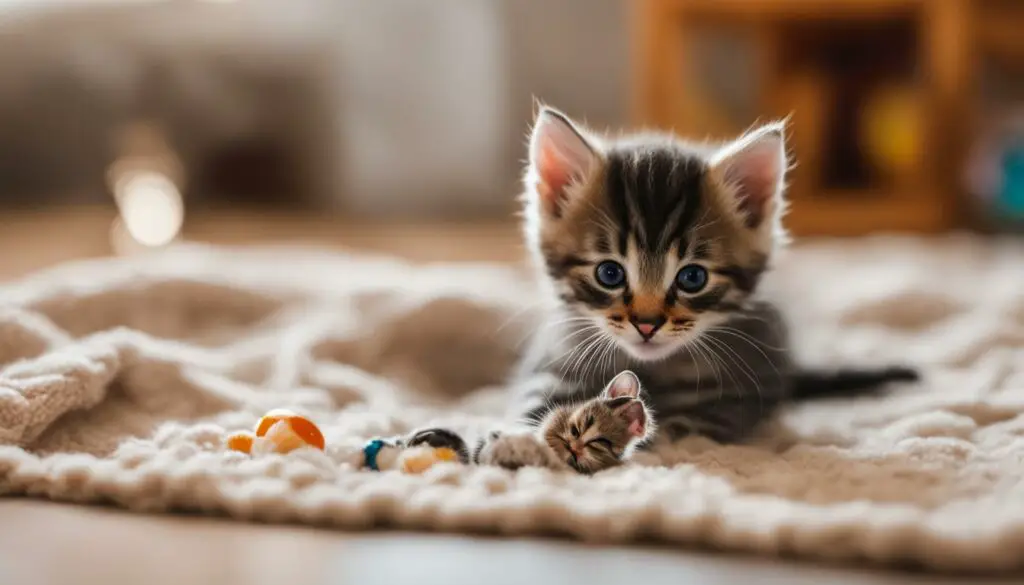
By understanding and supporting the developmental milestones of three-week-old kittens, we can ensure they have a nurturing environment where they can thrive. Their increased mobility, curiosity, and playfulness are all signs of healthy growth and progress. As they continue to grow, it’s important to provide ongoing care, stimulation, and love, setting them up for a happy and fulfilling life.
Developmental Milestones of Four-Week-Old Kittens
At four weeks old, kittens show significant advancements in both their physical and behavioral development. They have become more coordinated and can now walk with better stability, eagerly exploring their surroundings. Their social skills are also improving as they engage in play with their littermates, learning important social cues and boundaries.
One of the notable milestones at this stage is the ability to urinate and defecate on their own. They start to show signs of litter box training, making it an ideal time to introduce them to a shallow litter box with kitten-safe litter. It’s important to provide a consistent and comfortable environment for their continued growth and development.
As their physical abilities progress, their curiosity and desire for stimulation increase. Providing them with appropriate toys and playtime not only encourages their physical development but also stimulates their mental and cognitive abilities. This is an opportune time to introduce interactive toys that promote exercise and cognitive engagement, helping them develop into well-rounded adult cats.
Furthermore, at four weeks old, it’s crucial to gradually introduce solid food into their diet. Start by offering a high-quality kitten food mixed with warm water to create a soft gruel-like consistency. As they become more accustomed to the texture and taste, you can gradually reduce the amount of water and increase the amount of solid food. It’s important to monitor their appetite and ensure they are eating enough to support their growth.
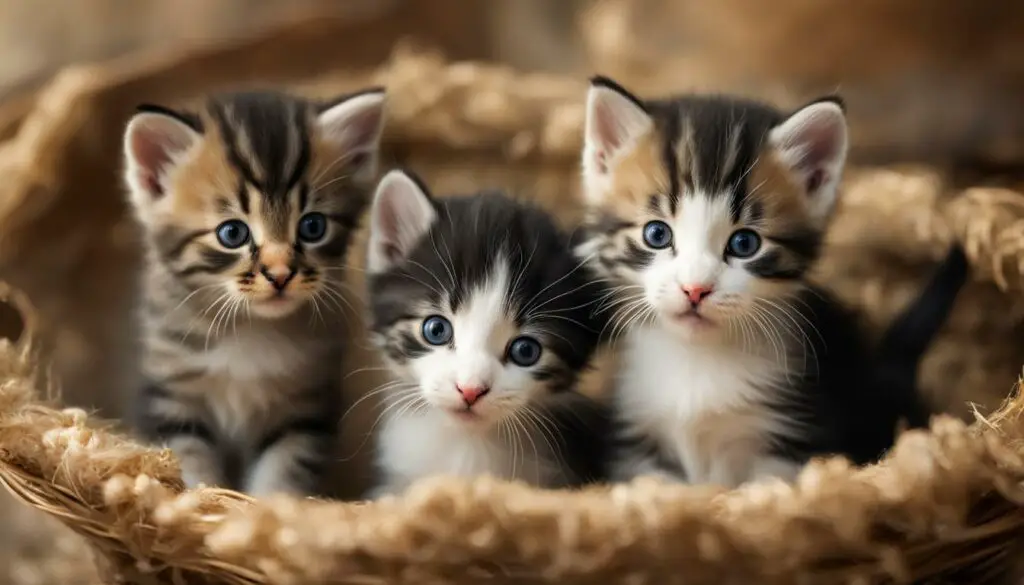
Developmental Milestones of Four-Week-Old Kittens:
| Physical Development | Behavioral Development |
|---|---|
| Improved coordination and walking ability | Engaging in play with littermates |
| Urinating and defecating without assistance | Exploring their environment |
| Introduction to litter box training | Increased curiosity and desire for stimulation |
| Gradual introduction to solid food | Growing social skills and interactions |
In summary, four-week-old kittens display significant physical and behavioral advancements, including improved coordination, litter box training, exploration, and interactive play. This is also the time to introduce them to solid food, gradually transitioning them from a milk-based diet to a combination of solid and liquid food. By providing a nurturing and stimulating environment, we can ensure the healthy development of these adorable little felines.
Developmental Milestones of Five-Week-Old Kittens
Five-week-old kittens continue to grow physically and develop their behaviors. At this stage, they are becoming more independent and social, showing interest in interacting with humans and other animals. Their physical abilities are improving, and they are starting to experiment with solid food.
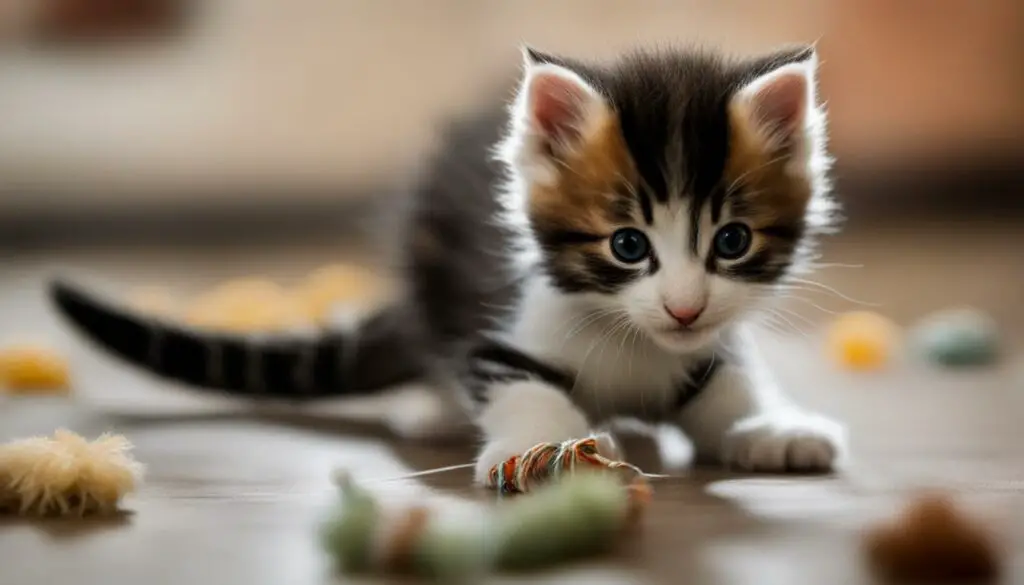
Physically, five-week-old kittens have better coordination and balance. They can walk more confidently and explore their surroundings with curiosity. Their muscles are developing, allowing them to engage in playful activities such as chasing toys and their littermates.
Behaviorally, five-week-old kittens are becoming more social. They may seek attention from humans, purring and rubbing against them. They also start to playfully interact with their littermates, engaging in wrestling and chasing games. This stage is crucial for their social development, as it helps them learn important communication and socialization skills.
| Physical Milestones | Behavioral Milestones |
|---|---|
| Improved coordination and balance | Seeking attention from humans |
| Exploring their surroundings more confidently | Playing with littermates |
| Engaging in playful activities | Developing communication and socialization skills |
As their growth progresses, it is important to monitor their development and provide appropriate care. Offer access to fresh water and gradually introduce dry food to their diet. Continue to provide a warm and stimulating environment, encouraging their physical and mental stimulation through interactive play and toys.
Remember to handle them gently and provide positive experiences, as this will contribute to their overall well-being and future social interactions. With proper care and nurturing, five-week-old kittens will continue to thrive and prepare for the next developmental stage.
Developmental Milestones of Six-Week-Old Kittens
By the time kittens reach six weeks old, they have made significant strides in their physical and behavioral development. At this stage, they exhibit more adult-like responses to smell and visual threats from other cats. Their sense of curiosity grows, and they become increasingly independent, exploring their surroundings and perfecting their grooming skills. It is important to continue providing a nurturing environment that supports their growth and development.
One noticeable change in six-week-old kittens is their improved coordination and balance. They move with greater ease and confidence, exhibiting more controlled movements. Their motor skills continue to develop, allowing them to climb and jump with increasing agility. This is a crucial time to ensure their surroundings are safe and free from potential hazards.
Kittens at six weeks old become more social and interactive. They enjoy human interaction and may begin seeking attention and affection. It is important to provide positive socialization experiences during this critical period to foster their emotional well-being. Engaging in play sessions with appropriate toys helps stimulate their minds and keeps them active and entertained.
| Physical Development | Behavioral Development |
|---|---|
| Kittens show improved coordination and balance. | They become more independent and curious. |
| Their motor skills develop further. | They explore their surroundings and perfect grooming skills. |
| They can climb and jump with increased agility. | They become more social and seek human interaction. |
In conclusion, six-week-old kittens have come a long way in their development. They are becoming more independent, exhibiting improved coordination, and showing increased curiosity about the world around them. Providing a nurturing environment that supports their physical and behavioral development is crucial at this stage. By continuing to offer appropriate food, water, and social interaction, we can ensure that these kittens grow into healthy and well-adjusted adult cats.
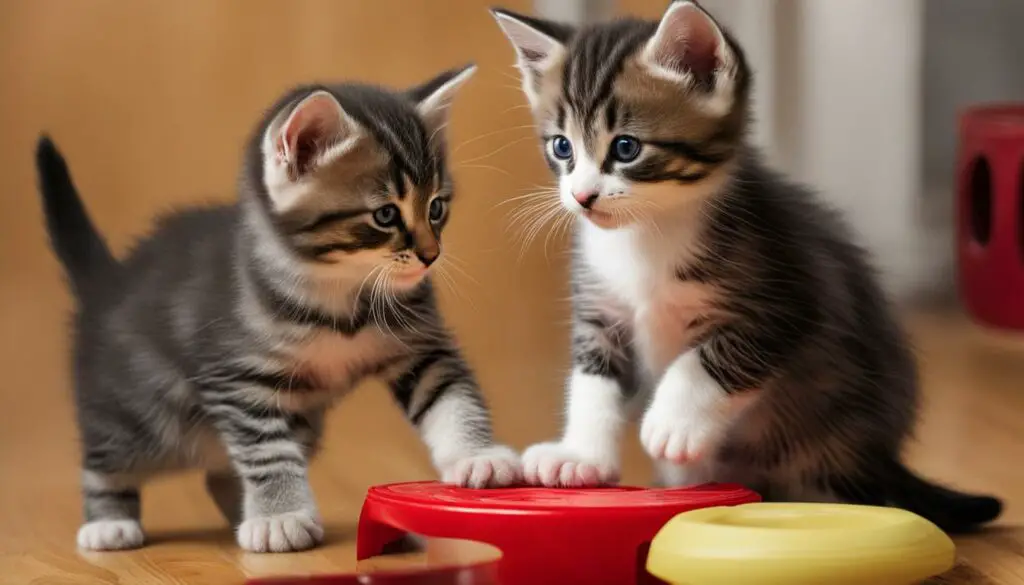
Caring for Kittens Under 5 Weeks Old
When it comes to caring for kittens under 5 weeks old, there are a few key considerations to keep in mind. These young kittens require special attention and care to ensure their health and wellbeing.
If the mother is absent or unable to care for the kittens, bottle feeding may be necessary. Bottle feeding allows you to provide them with the necessary nutrition they need to thrive. It’s important to establish a feeding schedule based on their age, with younger kittens needing more frequent feedings. This ensures they receive the proper nourishment and helps support their growth and development.
In addition to feeding, you’ll also need to assist with toileting. Kittens under 5 weeks old rely on their mother to stimulate their bowels and bladder. Since they don’t have their mother, you’ll need to gently assist them with toileting after each feeding. This can be done by using a soft cloth to clean their lower belly, genital area, and anal region.
Monitoring their health closely is vital during this stage. Keep an eye out for any signs of illness or distress and consult a veterinarian if needed. Providing a warm and clean environment, along with plenty of love and attention, will help ensure the kittens thrive during this critical stage of their development.

Table: Bottle Feeding Schedule for Kittens Under 5 Weeks Old
| Age (Weeks) | Number of Feedings per Day | Amount per Feeding (in ml) |
|---|---|---|
| 1 | 6-8 | 5-10 |
| 2 | 5-7 | 10-15 |
| 3 | 4-5 | 15-20 |
| 4-5 | 3-4 | 20-25 |
Table: Bottle Feeding Schedule for Kittens Under 5 Weeks Old. This table provides a general guideline for the number of feedings and amount per feeding based on the age of the kittens. It’s important to note that individual kittens may have different needs, so it’s always best to consult with a veterinarian for personalized advice.
Preparing to Care for Bottle-Fed Kittens
When it comes to caring for bottle-fed kittens, proper preparation is key. By ensuring you have all the necessary supplies and setting up a suitable environment, you can provide the best care for these adorable little ones.
To start, you will need to gather the following items:
- Kitten formula: Choose a high-quality formula specifically designed for kittens. Avoid using cow’s milk as it can upset their delicate stomachs.
- Nursing kit: This should include bottles and nipples designed for kittens. Opt for bottles with small openings to mimic the mother’s nipples.
- Kitchen scale: This will help you monitor the kittens’ weight gain and ensure they are growing at a healthy rate.
- Carrier or cage: Provide a safe and comfortable space for the kittens to rest and sleep. Line it with soft bedding and ensure it has a heat source to maintain their body temperature.
It’s important to keep bottle-fed kittens separated from other pets to prevent the spread of disease. Set up a designated area where they can receive round-the-clock care and attention.
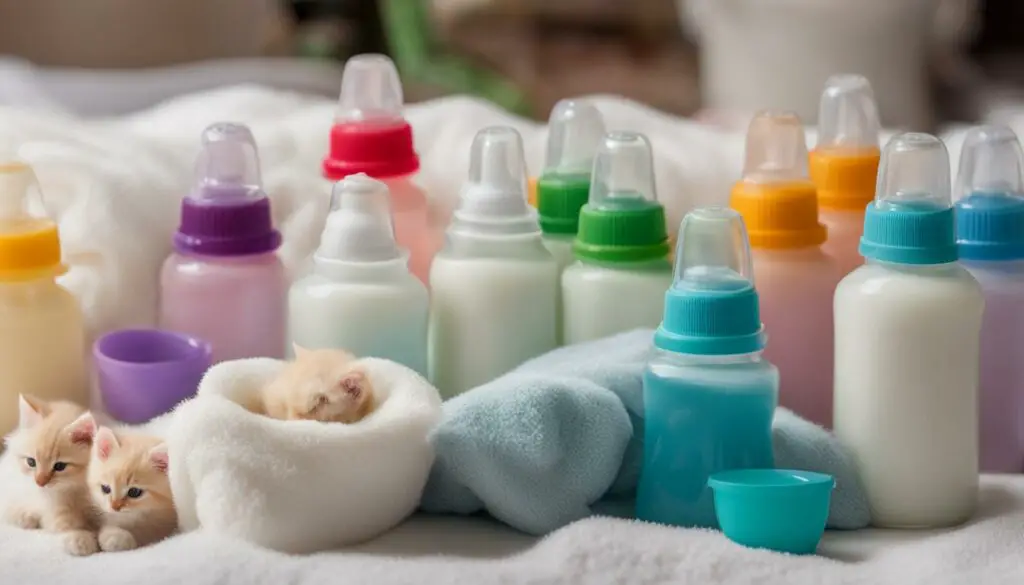
By preparing ahead of time and having the necessary supplies at hand, you can give bottle-fed kittens the love and care they need to thrive and grow.
Feeding Bottle-Fed Kittens
Feeding bottle-fed kittens requires careful attention to their nutritional needs and a consistent schedule. It is important to follow the bottle feeding schedule recommended by experts and adjust it according to the age and development of the kittens. Kittens under 2 weeks old should be fed every 2-3 hours, while older kittens can be fed every 4-6 hours. The feeding schedule should be spread evenly throughout the day and night to ensure they receive adequate nourishment.
When bottle feeding, it is essential to position the kittens in a similar manner to how they would nurse from their mother. Hold them in a slightly elevated position, allowing them to suckle comfortably. It is recommended to use a high-quality kitten milk replacement formula, as cow’s milk can cause digestive issues in kittens. Formula should be warmed to body temperature, and the kittens should be allowed to drink at their own pace.
While feeding, it is important to monitor the kittens closely for any signs of discomfort or indigestion. Gentle burping should be done after each feeding to help release any trapped air. Simply hold the kitten over your shoulder or in an upright position and lightly pat their back until they burp. This will help prevent digestive issues and promote their overall well-being.
| Feeding Schedule | Age | Frequency |
|---|---|---|
| Morning | 2 weeks old | Every 2-3 hours |
| Afternoon | 3-4 weeks old | Every 4-6 hours |
| Evening | 5-6 weeks old | Every 4-6 hours |
Bottle feeding provides essential nutrition for growing kittens, but it is also a bonding experience. It is important to create a calm and quiet environment during feedings, minimizing distractions and allowing the kittens to focus on nourishing themselves. This time together can strengthen the human-kitten bond and contribute to their overall socialization.
Toileting and Hygiene for Bottle-Fed Kittens
Proper toileting and hygiene practices are crucial for the well-being of bottle-fed kittens. Since they don’t have a mother to stimulate their bowels, it’s important to assist them with eliminating waste. After each feeding, gently clean their lower belly, genital area, and anal area using a soft cloth or cotton ball dampened with warm water. This helps to stimulate their natural elimination reflex and keeps them clean.
Monitoring the frequency and type of their elimination is also important. Kittens should have regular bowel movements, typically after each feeding. The stool should be soft and well-formed. If you notice any abnormalities in their elimination patterns, such as diarrhea or constipation, it’s advisable to consult a veterinarian for further guidance.
In addition to toileting, regular hygiene practices are necessary to keep bottle-fed kittens clean and prevent infections. You can use a moist cloth to gently wipe their fur, paying particular attention to areas that may accumulate dirt or urine. Make sure to avoid getting them too wet, as kittens are sensitive to cold and can easily become chilled. If you notice any signs of skin irritation or odor, it’s best to consult with a veterinarian for appropriate treatment.
The Importance of a Clean Environment
Creating a clean and hygienic environment for bottle-fed kittens is essential for their overall health and well-being. Their bedding should be kept clean and dry, as damp bedding can harbor bacteria and lead to skin infections. Regularly wash their bedding using a mild detergent and hot water, ensuring thorough rinsing to remove any residue that may cause irritation.
It’s also important to keep the feeding area clean. Wash and sanitize the bottles, nipples, and any utensils used for preparing their formula after each use. Use a bottle brush or a small brush specifically designed for cleaning nipples to remove any remaining formula or debris. Ensure that all equipment is thoroughly dried before reusing.
By maintaining proper toileting and hygiene practices and providing a clean environment, you can help ensure the health and comfort of bottle-fed kittens. Remember to consult with a veterinarian if you have any concerns or questions regarding their care.
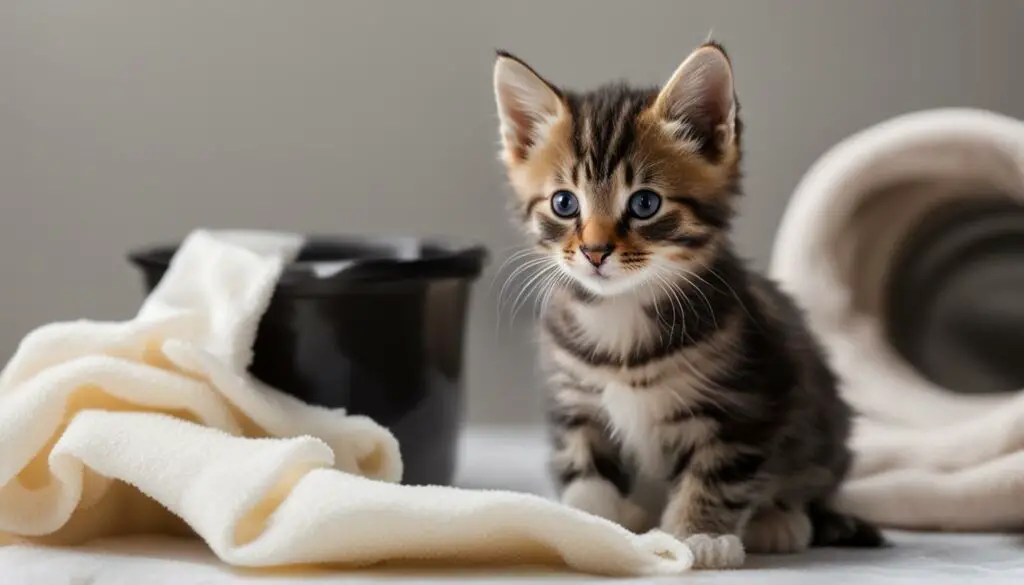
Weaning Bottle-Fed Kittens
When bottle-feeding kittens, the process of weaning is a significant milestone in their development. It involves gradually introducing solid food and transitioning them from relying solely on formula to becoming independent eaters. Weaning typically begins around 4 weeks of age and continues until the kittens are eating solid food on their own, usually around 6 to 8 weeks.
To initiate the weaning process, start by offering small amounts of formula on a spoon or your hand. This allows the kittens to explore the taste and texture of solid food. As they become more comfortable, gradually transition to a shallow dish or saucer with formula. It’s essential to monitor their digestion during this stage, as some kittens may experience slight stomach upset or loose stools as they adjust to the new diet.
As the kittens become more adept at eating solid food, you can begin adding small amounts of canned kitten food mixed with formula. This helps them transition from a liquid diet to a solid one. Monitor their digestion and adjust the ratio of formula to solid food accordingly. They should still have access to fresh water for hydration.
| Week | Weaning Milestones |
|---|---|
| 4 weeks | Introduce small amounts of solid food mixed with formula |
| 5 weeks | Gradually increase the amount of solid food and decrease the amount of formula |
| 6 weeks | Kittens should be eating primarily solid food with minimal formula supplementation |
During the weaning process, it’s important to closely monitor the kittens’ overall health and weight gain. If you notice any significant changes or concerns, consult with a veterinarian for guidance. Additionally, provide a clean and comfortable environment for the kittens to eat and explore, encouraging their independence and development along the way.

Summary
- Weaning is a gradual process that typically starts around 4 weeks of age.
- Introduce solid food by offering small amounts on a spoon or hand.
- Transition to shallow dishes or saucers with formula.
- Gradually increase the proportion of solid food mixed with formula.
- Monitor digestion and adjust the ratio of formula to solid food accordingly.
- By 6 weeks, kittens should be primarily eating solid food with minimal formula supplementation.
- Monitor the kittens’ health and weight gain throughout the weaning process.
Conclusion
Understanding the developmental stages of kittens is essential for nurturing them and promoting healthy growth. From their first moments as blind and helpless newborns to their independent and curious nature as six-week-old kittens, each stage brings unique milestones and requirements.
During the first weeks, newborn kittens rely on their mother for everything, including feeding, warmth, and cleaning. As they grow, their physical and behavioral development progresses, allowing them to explore their surroundings, interact with others, and perfect their coordination and grooming skills.
Providing a warm and stimulating environment, along with proper nutrition and care, is vital in ensuring the healthy growth and development of kittens. From bottle-feeding and assisting with toileting to gradually introducing solid food and monitoring their digestion, every step plays a significant role in their overall well-being.
By understanding the journey of kitten development and providing the necessary support, we can help them thrive into happy and healthy adult cats. So let’s embrace the joy of nurturing these little creatures, knowing that we are shaping their lives and promoting their well-being every step of the way.
FAQ
When should I stop stimulating kittens for healthy growth?
It is important to stop stimulating kittens after the first eight weeks of their life to allow them to develop naturally.
What are the developmental milestones of newborn kittens?
Newborn kittens are born blind and defenseless. They rely on their mother for feeding, cleaning, and bathroom support. They start to open their ears and eyes gradually and sleep for the majority of the day.
What are the developmental milestones of one-week-old kittens?
One-week-old kittens begin to open their eyes and ears slowly. They can hold their heads up and move their limbs, but they are still mostly uncoordinated.
What are the developmental milestones of two-week-old kittens?
Two-week-old kittens start to show signs of improved coordination and may attempt their first steps. Their vision is developing, and their eyes are fully open.
What are the developmental milestones of three-week-old kittens?
Three-week-old kittens show improvements in their eyesight and may begin to explore their surroundings. They become more active and curious, taking their first wobbly steps.
What are the developmental milestones of four-week-old kittens?
Four-week-old kittens become more advanced in their physical and behavioral development. They can urinate and defecate on their own, start to explore their environment, and play with their littermates.
What are the developmental milestones of five-week-old kittens?
Five-week-old kittens continue to develop physically and behaviorally. They start to munch on solid food and perfect their litter box skills. They become more social and interactive.
What are the developmental milestones of six-week-old kittens?
Six-week-old kittens show adult-like responses to smell and visual threats. They become more independent, curious, and develop grooming skills.
How do I care for kittens under 5 weeks old?
Care for kittens under 5 weeks old includes providing proper nutrition, warmth, hygiene, and monitoring their health closely. Bottle feeding may be necessary.
How do I prepare to care for bottle-fed kittens?
To care for bottle-fed kittens, you will need supplies such as kitten formula, a nursing kit, a kitchen scale, and a carrier or cage with bedding and a heat source.
How often should I feed bottle-fed kittens?
Bottle-fed kittens require round-the-clock feedings, with the frequency depending on their age. Follow the directions on the formula packaging and monitor their weight gain.
How do I assist with toileting for bottle-fed kittens?
Gently clean the lower belly, genital, and anal area after each feeding to help bottle-fed kittens eliminate waste. Monitor their elimination frequency and type.
How do I wean bottle-fed kittens?
Weaning is a gradual process that starts around 4 weeks of age. Offer formula on a spoon or hand, transition to a saucer with formula, and gradually introduce small amounts of canned food.
What should I know about the care of bottle-fed kittens?
Caring for bottle-fed kittens involves providing proper nutrition, warmth, hygiene, and gradually transitioning to solid food. Monitor their growth and development closely.
What should I do to promote the healthy growth of kittens?
By understanding the developmental stages of kittens and providing the right environment, nutrition, and support, you can ensure their healthy growth and development.








